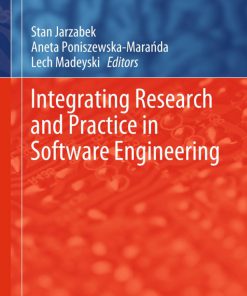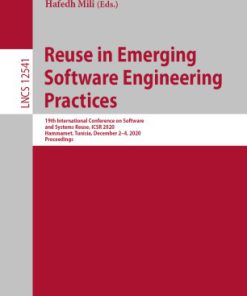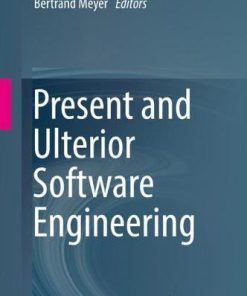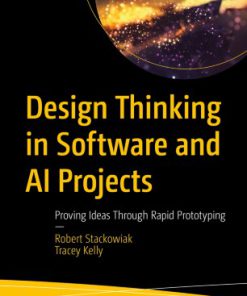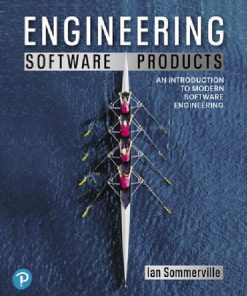Creating and Using Virtual Prototyping Software Principles and Practices 1st Edition by Douglass Post, Richard Kendall ISBN 0136566936 9780136566939
$50.00 Original price was: $50.00.$25.00Current price is: $25.00.
Creating and Using Virtual Prototyping Software Principles and Practices 1st Edition by Douglass E. Post, Richard P. Kendall – Ebook PDF Instant Download/Delivery: 0136566936, 978-0136566939
Full download Creating and Using Virtual Prototyping Software Principles and Practices 1st Edition after payment

Product details:
ISBN 10: 0136566936
ISBN 13: 978-0136566939
Author: Douglass E. Post, Richard P. Kendall
Develop, Deploy, and Sustain High-Performance Virtual Prototyping for Advanced R&D
Organizations must reduce time-to-market, costs, and risks while producing higher-quality products that grow ever more complex. In response, many are turning to advanced software for rapidly creating and analyzing virtual prototypes, and accurately predicting the performance and behavior of the systems they represent. This requires a deep understanding of physics-based digital engineering and high-performance computing, as well as unique organizational and management skills. Now, Douglass Post and Richard Kendall bring together knowledge that engineers, scientists, developers, and managers will need to build, deploy, and sustain these specialized applications—including information previously available only in proprietary environments.
Post and Kendall illuminate key issues with a detailed book-length case study based on their work at the U.S. DoD’s pioneering Computational Research and Engineering Acquisition Tools and Environments (CREATE) program, which developed eleven of the field’s most advanced software tools.
You’ll find a detailed roadmap for planning, organizing, managing, and navigating complex organizations to successful delivery; as well as detailed descriptions of each step in the process, with clear rationales and concrete examples. The authors share detailed references, a convenient glossary and bibliography, sidebars on overcoming real-world challenges, and more. The book reviews the essentials of computational engineering and science and the pivotal role of virtual prototyping. It helps readers to:
- Plan and manage the paradigm shift from physical to virtual prototyping
- Establish, execute, and evolve Agile processes for developing virtual prototyping software
- Understand and implement virtual prototyping tools and workflows
- Verify and validate prototyping systems to ensure accuracy and utility
- Recruit and retain a specialized workforce, and train and support users
- Explore additional emerging roles for virtual prototyping
Creating and Using Virtual Prototyping Software Principles and Practices 1st Table of contents:
Chapter 1: The Power of Physics-Based Software for Engineering and Scientific Research
- 1.0 A New Product Development Paradigm
- 1.1 Computational Engineering and Virtual Prototypes
- 1.2 Computational Science and Digital Surrogates
- 1.3 The Computational Engineering and Science Ecosystem
- 1.4 High-Performance Computers: The Enablers
- 1.5 Full-Featured Virtual Prototypes
- 1.6 The Advantages of Virtual Prototyping for Systems of Systems
- 1.7 Virtual Prototyping: A Successful Product Development and Scientific Research Paradigm
- 1.8 Historical Perspective
Chapter 2: The Computing Ecosystem
- 2.0 Introduction
- 2.1 The Commodity Components
- 2.2 Unique Components
- 2.3 Software Development Is Different
Chapter 3: Getting the Right Software for the Virtual Prototyping Paradigm
- 3.0 Introduction
- 3.1 Benefits and Shortcomings of the Choices
- 3.2 Managing Expectations: The CREATE Experience
- 3.3 Intellectual Property (IP) Management
- 3.4 Factors to Consider When Choosing a Software Option
- 3.5 Factors Impacting Internal (In-House) Software Development
Chapter 4: Examples of Virtual Prototyping Software (Tools)
- 4.0 Introduction
- 4.1 The Research Heritage
- 4.2 A Brief Description of the Tool Chain That Enables Virtual Prototyping for Products
- 4.3 Workflows
Chapter 5: Applying Virtual Prototyping Tools to Develop Product and Conduct Research
- 5.0 Introduction
- 5.1 The Broad Reach of Computational Engineering and Science
- 5.2 Establishing the Value of Virtual Prototyping for Product Development or Scientific Research
- 5.3 A Case Study of the Value of Virtual Prototyping
- 5.4 ROI Redux
- 5.5 Weather Forecasting: A Computational Scientific Research Example
- 5.6 Representative Impacts of the CREATE Software Applications to DoD Program
- 5.7 Lessons Learned and Perspectives
Chapter 6: Developing and Marketing a Proposal to Establish a Program to Develop Virtual Prototyping Tools
- 6.0 Introduction: Change Is Hard
- 6.1 Recommended Steps to Develop and Market a Proposal to Establish a Virtual Prototyping Program
- 6.2 Executing the Proposal Development Phases
- 6.3 Summary of Lessons Learned from Virtual Prototyping Software Program Startups
Chapter 7: Creating and Sustaining Software Development Programs for Virtual Prototyping Tools
- 7.0 Introduction
- 7.1 Recommended Steps for Starting and Sustaining Software Development Programs for Virtual Prototyping Tools
- 7.2 Establishing a Software Development Program for Virtual Prototyping Tools
- 7.3 Summary
Chapter 8: Managing the Software Development Program for Virtual Prototyping Applications
- 8.0 Introduction
- 8.1 Programmatic Risks
- 8.2 Risk Management by Principles and Practices
- 8.3 Program Management Policies
- 8.4 Examples of Risk-Based Management Principles from CREATE
- 8.5 Risk-Mitigating Program Management Practices
- 8.6 Program Organization: The CREATE Example
- 8.7 Keeping Track Across Disparate Domains of the CREATE Federation
- 8.8 How It All Comes Together: The Product Development Cycle
- 8.9 Summary and Lessons Learned
Chapter 9: Executing a Software Development Program for Virtual Prototyping Applications
- 9.0 Background
- 9.1 Execution Risk
- 9.2 Key Software Development Principles
- 9.3 Core Software Development Practices
- 9.4 Workflow Management Selection: Agile or Plan Driven
- 9.5 Workflow Management Documentation
- 9.6 Product Documentation
- 9.7 Lessons Learned
Chapter 10: Verifying and Validating Science-Based Software
- 10.0 Introduction
- 10.1 How Testing Is Organized in CREATE
- 10.2 Automated Testing
- 10.3 CREATE Testing Principles and Practices
- 10.4 An Example of the Application of the Practices
- 10.5 Lessons Learned
Chapter 11: Recruiting and Retaining the Workforce
- 11.0 General Description of the Workforce for the Development of Software for Virtual Prototypes
- 11.1 Why This Differs from Conventional Software Development
- 11.2 How Knowledge Workers Differ from Conventional Workers
- 11.3 Why Standard Management Methods Don’t Work with Knowledge Workers
- 11.4 What Motivates Knowledge-Based Workers
- 11.5 What Knowledge-Based Workers Need to Bring to This Endeavor (Software Development for Virtual Prototyping Applications)
- 11.6 What Is Required to Recruit These Knowledge-Based Workers
- 11.7 How to Find Knowledge-Based Workers
- 11.8 What Is Required to Retain Knowledge-Based Workers
- 11.9 The Importance of Teams
- 11.10 The Importance of Development Infrastructure and Support
- 11.11 Intellectual Property Issues and Other Legal Issues
- 11.12 Advantages of Virtual Prototyping for Workforce Development and Training
- 11.13 Summary
Chapter 12: Opportunities and Challenges for Virtual Prototyping in Engineering and Science
- 12.0 Where We Are Now (2020)
- 12.1 What Could Be Next for Virtual Prototyping?
- 12.2 Some Thoughts About the Future of Virtual Prototyping
- 12.3 In Conclusion
Postscript
- Lesson 1: Software is key, and it is different
- Lesson 2: Be careful with open-source software
- Lesson 3: Starting a virtual prototyping software development program is hard
- Lesson 4: Do not overpromise
- Lesson 5: Manage the risks
- Lesson 6: Strive for a lightweight management approach that emphasizes practices, not processes
- Lesson 7: Software testing is just as important as feature development
- Lesson 8: Automate the product development and testing process as much as possible
- Lesson 9: Competent software developers of the virtual prototyping enterprise are a precious commodity with special needs
- Lesson 10: Strongly encourage staff career development
- Lesson 11: “The funds must flow”
People also search for Creating and Using Virtual Prototyping Software Principles and Practices 1st:
creating and using virtual prototyping software
how to create a virtual world
creating and using virtual environment on jupyter notebook with python
use of virtual keyword
virtualbox creating a virtual machine
Tags:
Douglass Post,Richard Kendall,Creating,Using,Virtual,Prototyping,Software,Principles,Practices 1st
You may also like…
Computers - Computer Science
Integrating Research and Practice in Software Engineering Stan Jarzabek
Business & Economics
Business & Economics - Management & Leadership
Computers - Programming






